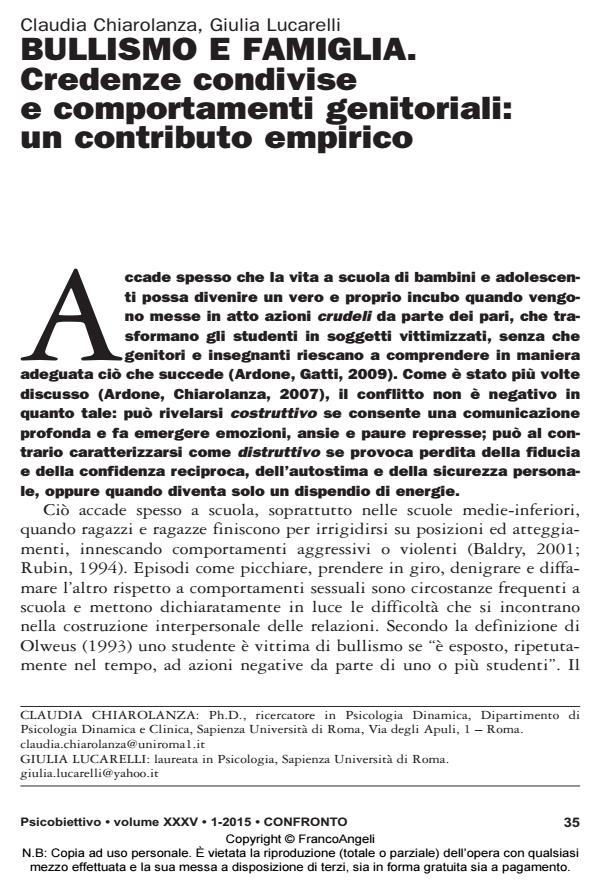Bullying and family. shared beliefs and parental behaviors: an empirical study
Journal title PSICOBIETTIVO
Author/s Claudia Chiarolanza, Giulia Lucarelli
Publishing Year 2015 Issue 2015/1 Language Italian
Pages 22 P. 35-56 File size 185 KB
DOI 10.3280/PSOB2015-001003
DOI is like a bar code for intellectual property: to have more infomation
click here
Below, you can see the article first page
If you want to buy this article in PDF format, you can do it, following the instructions to buy download credits

FrancoAngeli is member of Publishers International Linking Association, Inc (PILA), a not-for-profit association which run the CrossRef service enabling links to and from online scholarly content.
With the objective to study the antecedents of risky behavior in adolescents, the author examined the influence of parental risk beliefs on the development of adolescents risk’s beliefs. The study involved 41 families with adolescent between the ages of 14-17 years old. In particular, the specific objective was to: a) explore the presence of discrepancy between parents and adolescents; b) study the influence’s relationship between parent risk’s beliefs and adolescents’ risk’s beliefs; c) study the effect of variables such as opening, stress, control, referring which are all referred to the construct of parental monitoring, in such relationship. Results showed that parent risk’s beliefs significantly influence adolescent risk’s beliefs, but this influence is totally mediated from the adolescents’ perceptions of their parents’ beliefs. Among the variables referred to the construct of parental monitoring, only "control" seems to influence significantly adolescent risk’s beliefs. In particular, this variable exerts a total mediator effect in the relationship between adolescents’ risk’s beliefs and adolescents’ perceptions of their parents’ risk’s beliefs. In general, results support the current literature in emphasizing parental framework, as highly influencing the adaptive or maladaptive result of adolescent behavior.
Keywords: Adolescents; Family; Shared Beliefs; Risk Behaviors; Parental Monitoring; Parental Control.
- Ardone R., Chiarolanza C. (2007) Relazioni affettive. I sentimenti nel conflitto e nella mediazione, Il Mulino, Bologna
- Ardone R., Gatti C. (a cura di) (2009) Disagio adolescenziale e dispersione formativa dei giovani in obbligo formativo: una ricerca intervento nei centri di formazione professionale della Provincia di Roma, Kappa, Roma
- Baldry A.C. (2001) “Fattori individuali dei ragazzi prevaricatori e con tendenze devianti”, Giornale Italiano di Psicologia, 3: 643-649. DOI: 10.1421/36
- Baron R.M., Kenny D.A. (1986) “The Moderator-Mediator Variable Distinction in Social Psychological Research: Conceptual, Strategic, and Statistical Considerations”, Journal of personality and Social Psychology, 51, 6: 1173-1182.
- Bateson G., Bateson M. (1989) Dove gli angeli esitano. Verso un’epistemologia del sacro (trad. it.) Longo G., Adelphi, Milano
- Beebe B., Lachmann F. (2002) Infant Research and Adult Treatment: Co-Constructing Interactions, Analytic Press, Hillsdale, NJ
- Berti C. (1997) “La devianza adolescenziale. Seconda Edizione”, in Palmonari A. (a cura di), Psicologia dell’adolescenza, Il Mulino, Bologna
- Bonino S., Cattelino E., Ciairano S. (2005) Adolescents and risk. Behaviors, functions and protective factors, Springer-Verlag, Berlino, New York
- Byng-Hall J. (1973) “Family miths used as defence in conjoint family therapy”, British Journal of Medical Psychology, 46: 239-250. DOI: 10.1111/j.2044-8341.1973.tb02248.
- Carli L., Rodini C. (2008) Le forme dell’intersoggettività. L’implicito e l’esplicito nelle relazioni interpersonali, Raffaello Cortina, Milano
- Chiarolanza C. (2011) Dinamiche di regolazione affettiva nella valutazione del rischio in adolescenza, Presentazione al Convegno organizzato da Parsec Cooperativa, 2 dicembre 2011
- Collins W.A., Launsen B. (2006) “Parent-adolescent relationships”, in Noller P., Feeney J.A. (eds.), Close relationships: Function forms and processes, Psychology Press/Taylor & Francis, Hove, England, pp. 111-125. DOI: 10.1002/9780471726746.ch1
- De Leo G. (2003) “Funzioni e processi autoregolativi nella genesi del comportamento criminale”, Psicologia e Giustizia, 4, 1
- Farrington D.P., Jolliffe D., Loeber R., Stouthamer-Loeber M., Kalb L.M. (2001) “The concentration of offenders in families, and family criminality in the prediction of boys’ delinquency”, Journal of adolescence, 24 (5): 579-596. DOI: 10.1006/jado.2001.042
- Gilbert D., Fiske S.T., Lindzey G. (1998) The handbook of Social Psychology, Oxford University Press, New York
- Langos C. (2012) “Cyberbullying: The challenge to define”, Cyberpsychology, Behaviour and Social Networking, 15(6): 285-289, DOI: 10.1089/cyber.2011.058
- Markward M., Dozier C., Hooks K., Markward N. (2000) “Culture and the Intergenerational Transmission of Substance Abuse, Woman Abuse and Child Abuse: A Diathesis-Stress Perspective”, Children and Youth Services Review, 22: 237-250
- Mazzoni S., Tafà M. (a cura di) (2007) L’intersoggettività nella famiglia. Procedure multimetodo per l’osservazione e la valutazione delle relazioni familiari, FrancoAngeli, Milano
- Olweus D. (2003) Bullying at school. What we know and what we can do, Blackwell Publisher, Oxford (trad. it. Bullismo a scuola. Ragazzi oppressi, ragazzi che opprimono, Giunti, Firenze, 1996)
- Rubin K.H. (1994) “From family to peer group: Relations between relationships systems – An editorial”, Social Development, 3: v-x
- Smith C.A., Farrington D.P. (2004) “Continuities in antisocial behaviour and parenting across three generations”, Journal of Child Psychology and Psychiatry and allied disciplines, 45 (2): 230-47
- Steinberg L. (2000) “Youth Violence: Do Parents and Families make a difference?”, National Institute of Justice, April
- Thornberry T.P., Freeman-Gallant A., Lizotte A.J., Krohn M.D., Smith C.A. (2003) “Linked Lives: The Intergenerational Transmission of Antisocial Behaviour”, Journal of Abnormal Child Psychology, 31, 2: 171-184. DOI: 10.1023/A:102257420836
- Van Meurs I., Reef J., Verhulst F.C., Van Der Ende J. (2009) “Intergenerational Transmission of Child Problem Behaviors: a Longitudinal, Population-Based Study”, Journal of the American Academy of Child and Adolescent Psychiatry, 48(2): 138-145
- Velleman R. (2004) “Alcohol and drug problems in parents: an overview of the impact on children and implications for practice”, in Seriously disturbed and Mentally III Parents and their Children, 2nd Edition, Cambridge University Press, Gopfert J. Webster & M. Seeman, 13: 185-202
- Malagoli Togliatti M., Lubrano Lavadera A. (2002) Dinamiche relazionali e ciclo di vita della famiglia, Il Mulino, Bologna
Claudia Chiarolanza, Giulia Lucarelli, Bullismo e famiglia.Credenze condivise e comportamenti genitoriali: un contributo empirico in "PSICOBIETTIVO" 1/2015, pp 35-56, DOI: 10.3280/PSOB2015-001003